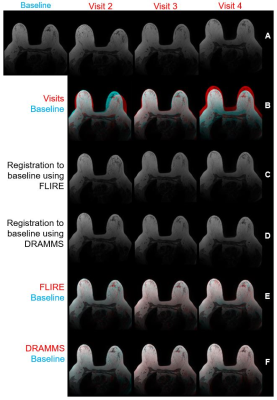Michelle W Tong1, Maren M. Sjaastad Andreassen2, Ana Rodríguez-Soto1, Christopher C Conlin1, Tyler Seibert3, Michael Hahn1, Rebecca Rakow-Penner1, and Anders M Dale1
1Radiology, University of California, San Diego, La Jolla, CA, United States, 2Circulation and Medical Imaging, Norwegian University of Science and Technology, Trondheim, Norway, 3Radiation Oncology, University of California, San Diego, La Jolla, CA, United States
1Radiology, University of California, San Diego, La Jolla, CA, United States, 2Circulation and Medical Imaging, Norwegian University of Science and Technology, Trondheim, Norway, 3Radiation Oncology, University of California, San Diego, La Jolla, CA, United States
This study compared a novel registration technique, Fast Longitudinal Image REgistration (FLIRE) to a well established method (DRAMMS) for longitudinal breast registration. The study found comparable accuracy, but at a 12-18× faster processing time.

Figure 1: (A,B) T1 images from a signal patient acquired throughout neoadjuvant chemotherapy treatment. (C,E) Images from follow-up visits were registered to baseline using FLIRE and (D,F) a well established registration program, DRAMMS. (E,F) Registered images are overlaid with baseline to evaluate differences. White indicates image similarities, blue is unique to baseline, and red is unique to the registered images. Both registration methods adequately correct for displacements in breast tissue.

Figure 3: To compare registration accuracy, similarity measures for each patient were averaged across time points. In the box plot, the red line indicates the median value across all patients, the box indicates the range of values between the 25th and 75th percentile, the whiskers indicate minimum and maximum values within 1.5 times the interquartile range, and the red plus signs indicate values beyond this range.